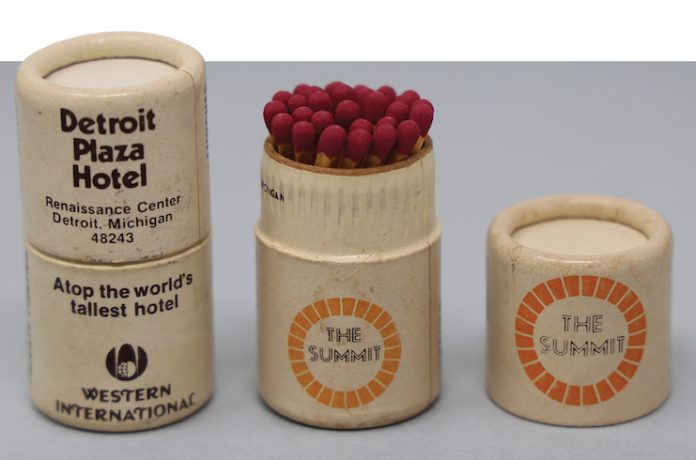A few years back, I wrote about the historical information that old hotel soap wrappers provide. I return with another historical artifact that also used to be a common product found in hotels, the matchbook. So common were branded matchbooks that they were easily accessible in the hotel lobby, and could also be found in the hotel bar, dining establishments, and guestrooms—often sitting on or near a clean ashtray. In a time when most Americans smoked cigarettes and cigars, they were seen as just another part of doing business. After all, providing a small matchbook was an easy way to be helpful to a guest. What is often overlooked was the strategic value of those small books of matches. Essentially, branded matchbooks were pocket-size advertisements as well as useful sources of guest information. The outside and inside covers often listed toll-free telephone numbers for reservations back when long-distance calls cost real money. Some matchbooks listed items that were available as perks at that particular hotel brand.
Case Studies
- A vintage Holiday Inn matchbook cover displays the familiar “Great Sign” that was a landmark for Holiday Inns. The brightly lit yellow and green sign with a shining star on top was legendary in mid-20th century America. Also appearing on the cover of the early matchbooks was John Holiday, the colonial innkeeper with a lit lantern. Holiday Inn used the John Holiday image as a tie-in to the historical innkeeper but with the new, modern motel geared for Americans traveling the new, modern highways. The colonial innkeeper, however, was phased out long before Holiday Inn jettisoned its Great Sign. Holiday Inn also strategically used its matchbooks for advertising, listing nine items behind the matches that guests could expect in their rooms, including “Free Ice,” “T.V. in every room,” and “swimming pool”—all without an extra fee. On the back of the matchbook cover, Holiday Inn announced that through its “Holidex” system, reservations could be made by computer, highlighting the company’s use of modern computer technology for guest reservations.
- In 1963, Western Hotels, based in Seattle, Washington, decided to change its name, reflecting the brand’s growth beyond the American West. The new name, Western International, reflected the company’s international development. One year later, the company designed a logo that would soon adorn its matchbook covers. This logo included a sleek and modern Western-style hat with an equally modern globe at the base of the hat. The logo tied the new company name back to its roots while also symbolizing its growth both domestically and internationally. Soon the logo was widely used on various Western International advertisements and collateral. While the cover of the matchbooks displayed the Western International logo, the inside cover gave the free 800 number for reservations.
- A Sheraton book of matches shows the image of the standardized highway sign seen at Sheraton Motor Inns, as they were called back in the 1960s. The sign in the image was called the “friendliest stop sign on the road,” and the matchbooks provided another way for Sheraton to advertise its company ethos. The inside cover listed the 90-plus domestic and international Sheraton Hotels and Inns. While the small font could be difficult to read, it does show that hotel companies saw matchbooks as good marketing devices.










